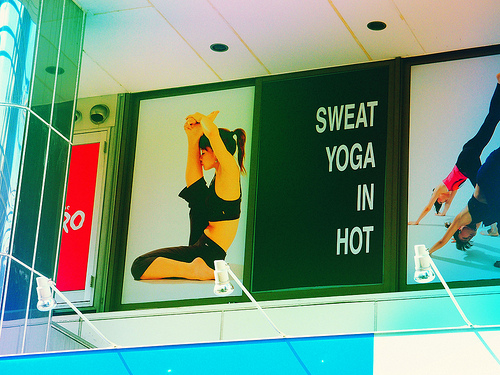Would You Like Abs With That?
You can hardly walk down the street without passing a yoga studio anymore.
It’s almost easier to find a yoga studio than a gas station in some parts of Denver and Boulder. Most would see this as a good thing, and it is. Almost anyone would rather see a yoga studio than a new fast food chain restaurant.
But what happens when yoga practice adapts the same fast food mentality that Americans seem to crave?
There could hardly be anything wrong with a growing population wanting to stretch, strengthen, breathe and take time to center and de-stress. I would not argue against this. The intention of this article is to take a few steps back and review the foundations of yoga and to compare these fundamentals with this yoga boom that has come to urban areas like a gold rush.
Thousands of years ago as yoga was developing, it probably looked very different than it does now.
There’s nothing wrong with that. We are hardly the people that we were then, but what has stayed true in the spirit of yoga and what has translated to our modern times?
The rishis and yogis of antiquity in India were not simpletons, they did not merely get lucky and discover the spiritual science of yoga. Yoga is thoroughly systematic and built on an intentional, logical structure with a clear-cut design and purpose.
Let’s start with a breakdown of Ashtanga yoga, or Eight Limbed yoga, which is referred to in Patanjal’s Yoga Sutras.
Though there are many methods and schools of thought in yoga, Ashtanga forms the basis for nearly all other traditions. There are eight steps in the tradition of Ashtanga, which will be outlined briefly, but cannot be looked at in depth in this article.
The Eight Limbs of Ashtanga Yoga:
1. Yama (Restraints): Non-violence, truthfulness, non-stealing, abstention and non-covetousness.
2. Niyama (Observances): Purity, contentment, austerity, self-study and meditation on the Divine.
3. Asana: Posture.
4. Pranayama: Breathing practices, control of prana or life force.
5. Pratyahara: Withdrawal of the senses from the external.
6. Dharana: Concentration, fixing one’s entire attention on a single object.
7. Dhyana: Contemplation of the object’s nature on which one is focusing.
8. Samadhi: Liberation, or merging with the object of contemplation.
When referring to yoga here in the West we’re usually just talking about asana, the postures and body movements of yoga.
In Ashtanga yoga, asana is one limb of this system.
Asana can literally be translated as seat, and this is a very literal definition of the purpose of this limb of yoga. The purpose of asana is to discipline and strengthen the body in order to sit. Certainly there is a lot more going on in the practice of asana than just sitting, as in any of the eight limbs of Ashtanga, but it is important to remember the way the original yogis viewed asana.
Asana is a rung on a ladder, but being extremely flexible is not at all the final aim of yoga.
Once the practitioner has learned control of the body, he or she can sit more comfortably for longer periods of time in order to move on to the next stages of yoga.
The first four limbs are considered external cleansing practices with the main intention and focus being on the last four limbs once the practitioner has withdrawn from the illusive nature of external reality.
Does it say anything about our culture that when we say yoga it automatically translates to an image of people making postures in a chic studio?
I’d like to make it clear that I am not soliciting a “right” way of practicing yoga, nor am I suggesting that there is one goal and one purpose for yoga. It is important for the individual to practice and contemplate yoga in her or his unique way.
The path of yoga is an independent experience, and no two people’s journey is the same.
If I could have one hope for this article, I would want for each reader to inquire within and seek his or her own intentions for practicing yoga. If it is just to feel good and exercise the body that is great, and if it is to achieve ultimate liberation from maya, the world of illusion, then that is great too.
Be a critical thinker, be honest and be loving to ourselves.
If we practice regularly at a studio, ask ourselves if that studio and its teachers align with our intentions and beliefs. If we are still unclear or unsure, then educate ourselves. There’s certainly never any harm in learning.
But most importantly, if yoga teaches us anything, it teaches us how to listen to our own wisdom.
Ask ourselves, practice some self-study, and determine what type of yoga works for us.
We can only ask, and wait for an answer, and that answer is ours to do with as we will. This life is our journey and if yoga is part of it, then consider the ancient foundations and decide for ourselves what aspects of tradition are important to us in this modern life.
Love elephant and want to go steady?
Sign up for our (curated) daily and weekly newsletters!
Apprentice Editor: Marcee Murray King/Editor: Rachel Nussbaum
Photo: Ray Larabie/Flickr












Read 0 comments and reply